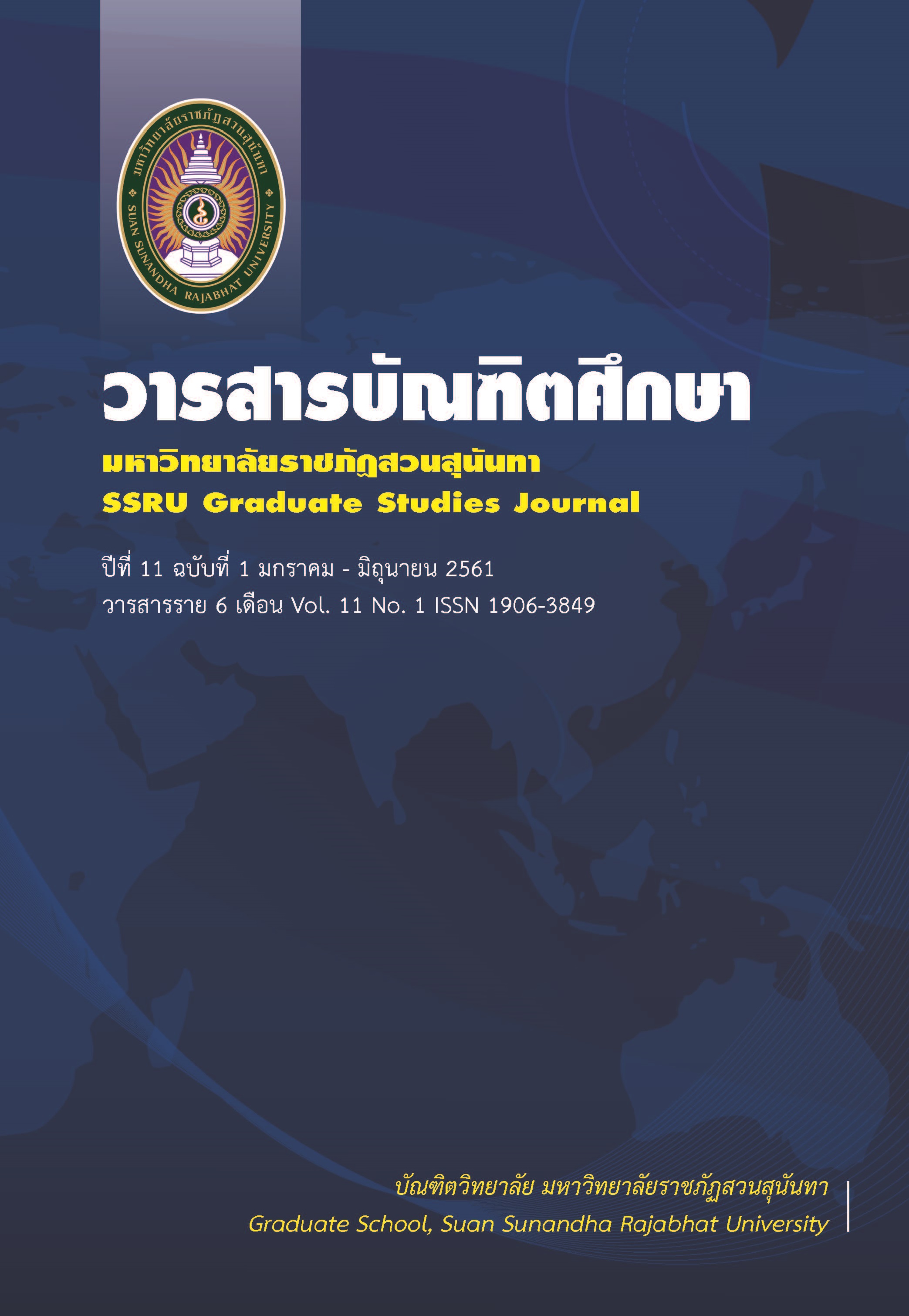The Influence of Organizational Culture and Innovation on the Competitiveness of Thai Leather Industry
Main Article Content
Abstract
The objective was to study (a) types of the organizational culture, (b) the levels of organizational culture, innovation, and competitiveness, and (c) causal structure model of competitiveness of Thai leather industry. The quantitative part of the research used questionnaire technique to collect data from 243 respondents, who were working in leather industry in Thailand, and the data collected were further analyzed using specialized statistical application. For the qualitative part, in-depth interview were used to collect data from leather business operators, leather specialists, and independent scholars. Findings revealed that the culture in Thai leather industry was focused on unique organizational strategies, employee engagement, teamwork, and leadership, success factors, human resource management and organizational uniqueness. The organizational culture was found to be at high level. Results from causal structure model in accordance with the hypothesis revealed that organizational culture had positive direct effects on organizational innovation but not on the competitiveness, and only innovation had positive direct effects on competitiveness, while it was also found that organizational culture and innovation in combination could predict the level of competitiveness of Thai leather industry well.
Article Details
References
Alpkan, L., Bulut, C., Gunday, G., Ulnsoy, G., Kilic, K. (2010). Organizational support for entrepreneurship and its interaction with human capital to enhance innovative performance. Management Decision, 48(5), 723- 755.
Boon-Itt, S. (2009). The cumulative model of competitive capabilities: an empirical analysis in Thai automotive industry. NIDA Development Journal, 49(3), 19-43.
Bullinger, H.J., Bannert, M., Brunswicker, S. (2007). Managing innovation capability in SMEs Tech. Monitor, Special Facture: Innovation & KM by SMEs, May – June, pp. 17-27.
Burgelman, R.A., Clayton, M.C., Wheelwright, S.C. (2004). Strategic management of technology and innovation. (4 th ed.). New York: McGrow-Hill/Irwin.
Cameron, K.S. & Quinn, R.E. (1999, 2006). Diagnosing and Changing Organizational Culture. Based on the competing values framework reading, MA; Addison-Wiseley (1999); Jossey-Bass (2006).
Camison, Z.C., Villar-Lopez, A. (2014). Organizational innovation as an enabler of technological innovation capabilities and firm performance. Journal of Business Research, 67(2014), 2891-2902.
Cooke, R. A. (1987). The Organizational Culture Inventory. Plymouth, MI: Human Synergistic, Inc.
Cooper, R.G. (2005). Product leadership: Pathway to profitable innovation. (2 nd ed.). New York: Perseus.
Dasanayaka, S.W. S.B. (2005). Implication of organization culture on innovativeness of export – oriented firms – A case study of gift and decorative ware industry in Sri Lanka. Euro – Asia Journal of Management, 18(2), 103-122.
Day, G.S., Wensley, R. (1988). Assessing advantage: A framework for diagnosing competitive superiority. Journal of Marketing, 52(2), 1-20.
Deal T.E. & Kenedy, A. A. (1982). Corporate Cultures: The Rites and Rituals of Corporate Life. Harmonsworth, Penguin Books.
Denison, D.R. (2001). Explaining size differences in smaller firms. International Small Business Journal, 19(2), 49-62.
Drucker, P.F. (1985). Innovation and Entrepreneurship. Butterworth-Heinemann, Oxford.
Gunday, G., Ulusoy., Kilic., K., Alpkan, L. (2011). Effects of innovation types on firm performance. International Journal of Production Economics, 133(2), 662-676.
Hamel, G. (2006). The why, what and how of management innovation. Harvard Business Review, February, 2006.
Handy, C.B. (1985). Understanding organizations. Published by Penguin Books, 1985. ISBN 10: 0-1400-9110-6 / ISBN 13: 9780-1400-9110-6.
Jokar, S., Talebbeydokhti, A. (2014). Investigating of the effect of supply chain activities on competitive capabilities in the Behnush beverage industry in Gachsaran. Indian Journal of Fundamental and Applied Life Science, 4(S4), 335-343.
Kenny, B., Reedy, I. (2006). The impact of organizational culture factors on Innovation levels in SME: An empirical investigation. The Irish Journal of Management, January, 119-142.
Kim, L. (1997). The dynamics of Samsung’s Technology learning in semiconductors. California Management Review, 39, 86-100.
Lawson, C.B., Samson, D. (2001). Developing innovation capability in organizations: A dynamic capability approach. International Journal of Innovation Management, 5(1), 377-400.
Marques, C.S., & Ferreira, J., (2009). SME innovative capacity, competitive advantage and performance in a “Traditional” industrial region of Portugal. Journal of Technology management & Innovation, 4(4), 53 – 68.
Martins, E., Martins, N. (2002). An organizational culture model to promote creativity and innovation. A Journal of Industrial Psychology, 28(4), 58-65.
Martins, E.C., Terblanche, F. (2003). Building organizational culture that stimulates creativity and innovation. European Journal of Innovation Management, 6(1), 64-74.
Muller, A., Valikangas, L., Merlyn, P. (2005). Metric for innovation: Guideline for developing a customized suite of innovation metrics. Strategic and Leadership, 33(1), 37-45.
Naranjo – Valencia, J.C. et al. (2011). Innovation or Imitation? The role of organizational culture. Management Decision, 49(1), 55-72.
Naranjo – Valencia, J.C., Valle, R.S., Jimenez, D.J. (2010). Organizational culture as determinant of product innovation. European of Innovation Management, 13(4), 466-480.
Porter, M.E. (1985–1990). Competitive advantage: creating and sustaining superior performance. The Free Press, New York.
Read, W.H. (1996). Managing the knowledge-based organization: Five prineiples every manager can use. Technology Analysis and Strategic Management, 8.
Schumpeter, J.A., (1934, 2012). The Theory of Economic Development. An inquiry into profits, capital, credit, interest and the business cycle, Journal of Comparison. Research in Anthropology and Sociology, 3(2), 2012, ISSN: 2068-0317.
Shan, W., Zhang, Q. (2009). Extension theory and its application in evaluation of independent innovation capability. Kybernetes, 38(3/4), 457-467.
Tang, H.K. (1998). An integrative model of innovation in organizations. Tech novation, 18 (5), 297-309.
Terziovski, M. (2007). Relationship of ISO9001: 2000 quality system certification with operational and business performance: A survey in Australia and New Zealand based manufacturing and service companies. Journal of Manufacturing Technology Management, 19(1), 22-37.
Yasil, S., Kaya, A. (2012). The role of organizational culture on innovation capability: An empirical study. International Journal of Information Technology and Business Management, 6(1), 11-25.


